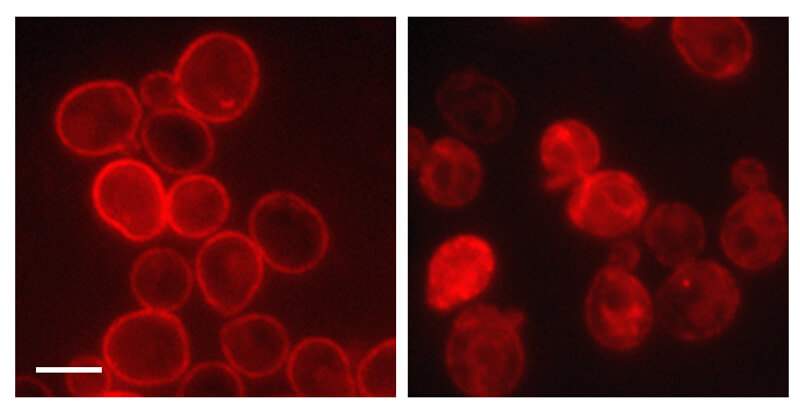Are you a journalist? Please sign up here for our press releases
Subscribe to our monthly newsletter:
In the movie Jack, directed by Francis Ford Coppola, Robin Williams plays a boy suffering from progeria, a rare disease in which children age rapidly and usually die before their twelfth birthday – white haired and wrinkled. Scientists study this cruel disease not only because they would like to find a way to slow down the accelerated aging in these children, but because it can give us clues to the normal process of aging.
Studies have begun to identify the genetic roots of the accelerated aging that occurs in progeria. And new research by Weizmann Institute scientists, which investigated what seemed to be an unrelated question, may now shed some additional light on the mechanisms behind the disease and on the process of aging in general.

Prof. Maya Schuldiner and her group set out to investigate a basic issue – the molecular mechanisms for maintaining the communication systems used by the cells to talk to one another. “The ability to send and receive the messages that pass between neighboring cells is vital. Without it, there would be no life,” says Schuldiner. “About 30% of the total energy expended by the cell goes to communication.” A good part of the communication process is conducted by proteins – for example, receptors on the cells’ outer membranes for taking in messages and secreted proteins that carry messages from the cells outward toward their neighbors.
Schuldiner’s group investigates such communication proteins. As soon as the proteins are manufactured – fresh from the ribosome – they are moved to a sort of “transfer gate” in the cell, something like the gates in airports where passengers who have already undergone a security check are held before boarding. This keeps these outward-bound messenger proteins separate from the rest of the body of the cell.
The proteins go into this transfer gate through a sort of “fence” with gaps. They must pass through these narrow gaps in an unfolded state, like a piece of string; only once they are inside the transfer gate area do they become folded into their characteristic shapes. “When a new protein starts moving through the tunnel, there are proteins that pull it in and do not let it slip back out,” says Schuldiner. “But the protein is longer than the tunnel. One end can be pulled into the transfer gate, and sometimes, the other can already start to fold.” This fold usually clogs the tunnel, rendering the entrance useless. If more of the tunnels get plugged this way, it can hamper the cell’s ability to send messages, and ultimately the cell may die.
Since proteins regularly fold, even where they are not supposed to, the team wondered whether the cell has a way to deal with clogs in the fences when partially folded proteins get stuck halfway through. To answer their question, the researchers engineered yeast cells to overexpress a protein that frequently clogs up the tunnel entrances. They ran their experiment on 6,200 different yeast cells – each missing a single one of the 6,200 genes in the yeast genome. As they reported in Cell, the team identified a sort of “plumber” protein called Ste24 that chops off the protein fold causing the clog. Ste24, a type of enzyme called a protease, frees the tunnels up for more messenger proteins to pass through. The scientists then created new yeast cells that were missing the plumber enzyme. These cells eventually died of clogged tunnels, unable to send out their crucial communication signals.

Ste24, says Schuldiner, has been conserved in evolution, so that there is almost no difference between the yeast version and one found in human cells known as ZMPSTE24. In fact, it is so well conserved that when the researchers inserted the gene for the human plumber enzyme into yeast cells, the cells not only produced the enzyme, but it functioned in an identical way in the yeast.
How does a cellular plumber tie in to aging? In human cells, when the ZMPSTE24 is held up and the tunnels increasingly clog up with half-folded proteins, the aging process becomes accelerated, something like a cellular version of progeria. If it turns out that our cellular plumbers slow down over time, thus damaging our cells’ communication systems and hastening the aging process, then we might find a way to reinforce the plumber (or send in a substitute) and thus, by improving the basic process of secretion, we might be able to slow aging.
Prof. Maya Schuldiner's research is supported by the Foundation Adelis; the Georges Lustgarten Cancer Research Fund; the Dora Yoachimowicz Endowed Fund for Research; the Berlin Family Foundation; Roberto and Renata Ruhman, Brazil; and Karen Siem, UK. Prof. Schuldiner is the incumbent of the Dr. Gil Omenn and Martha Darling Professorial Chair in Molecular Genetics.